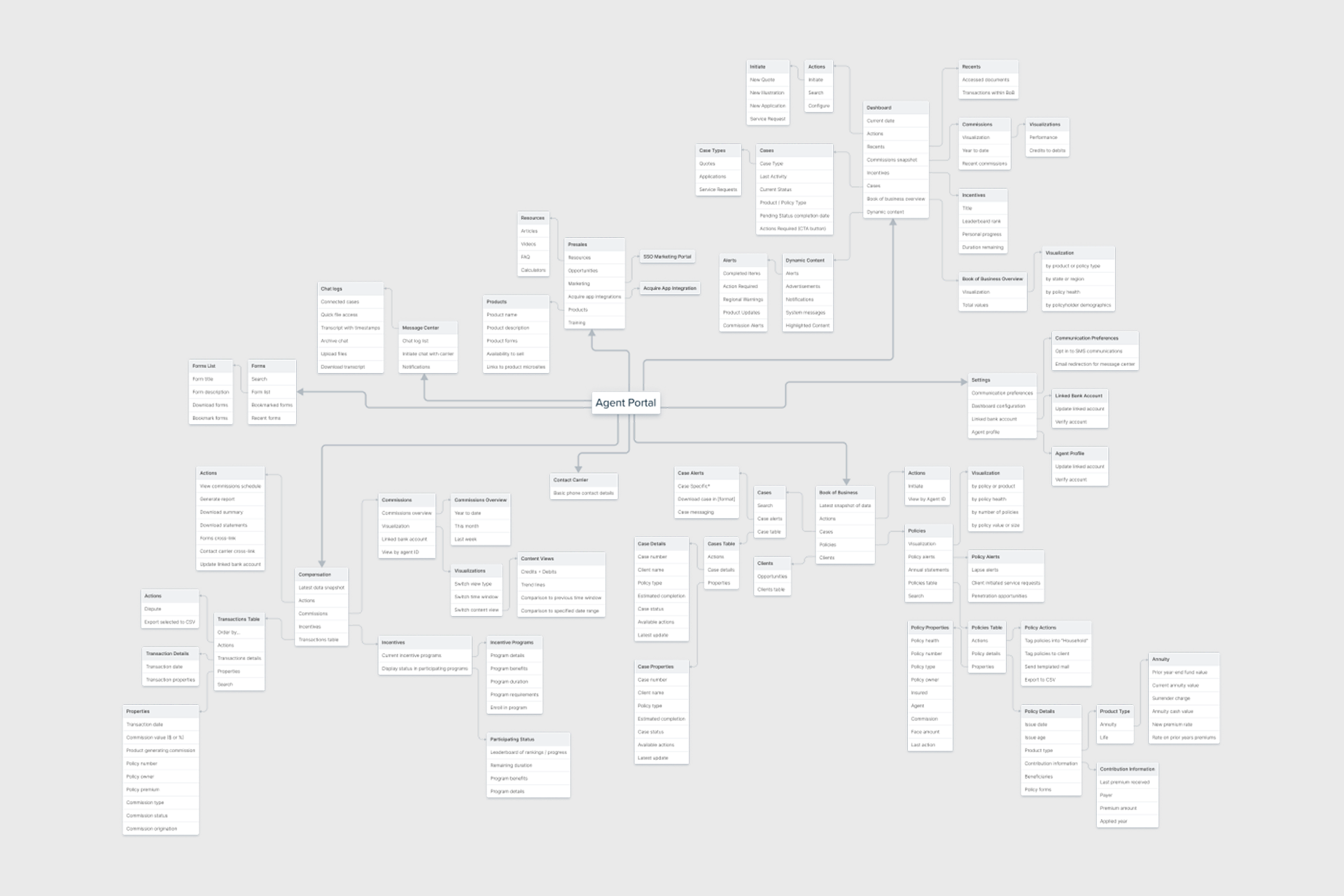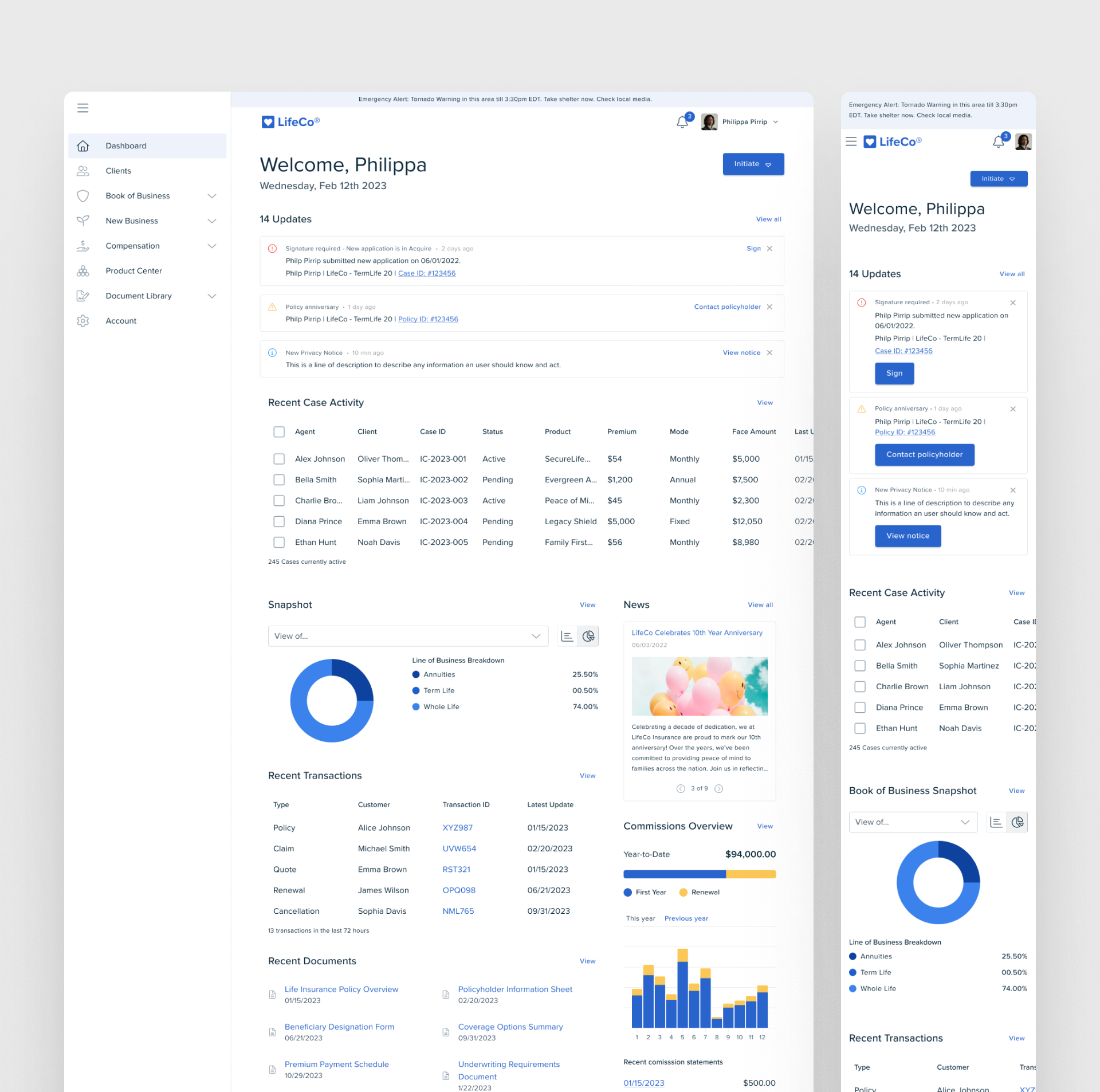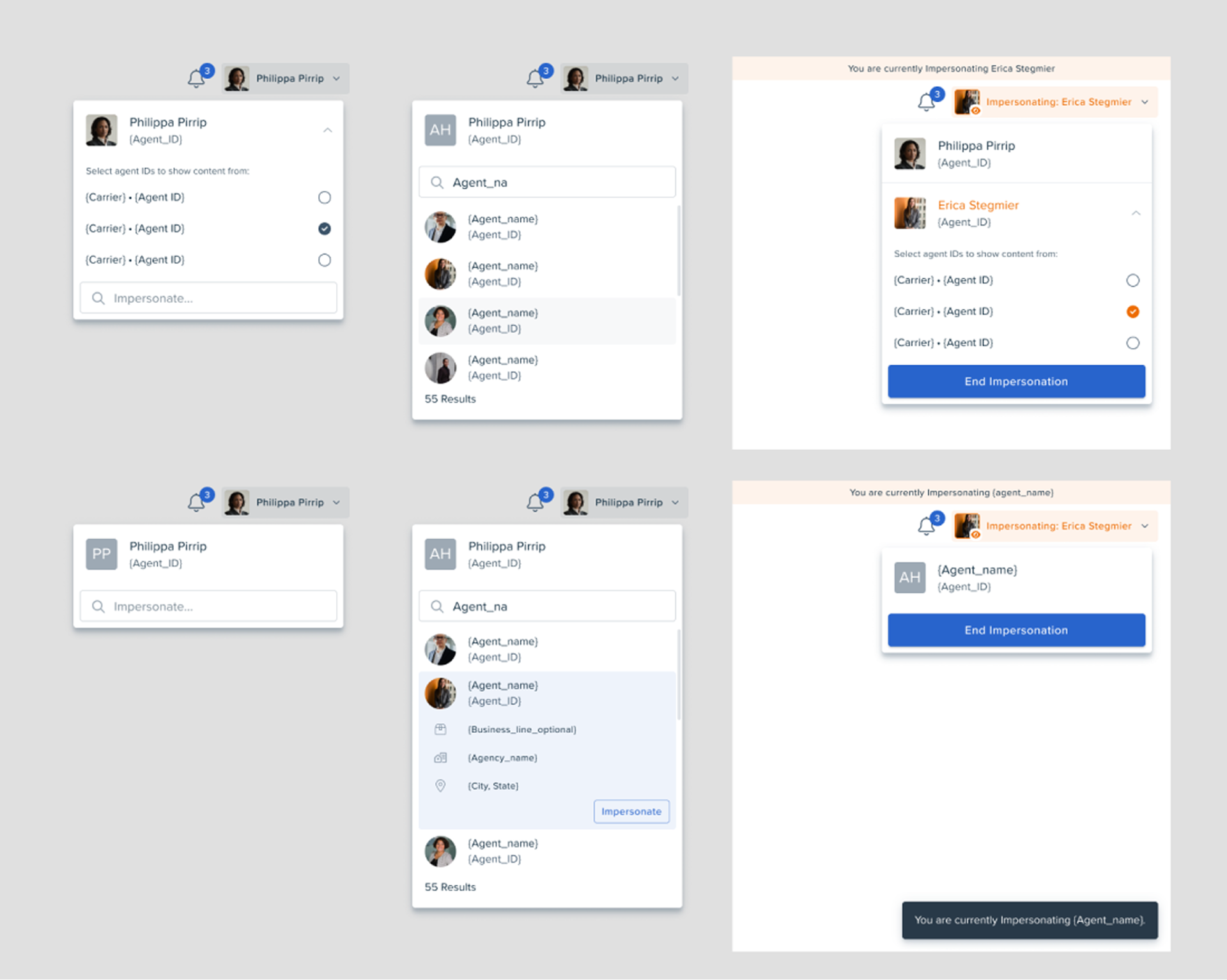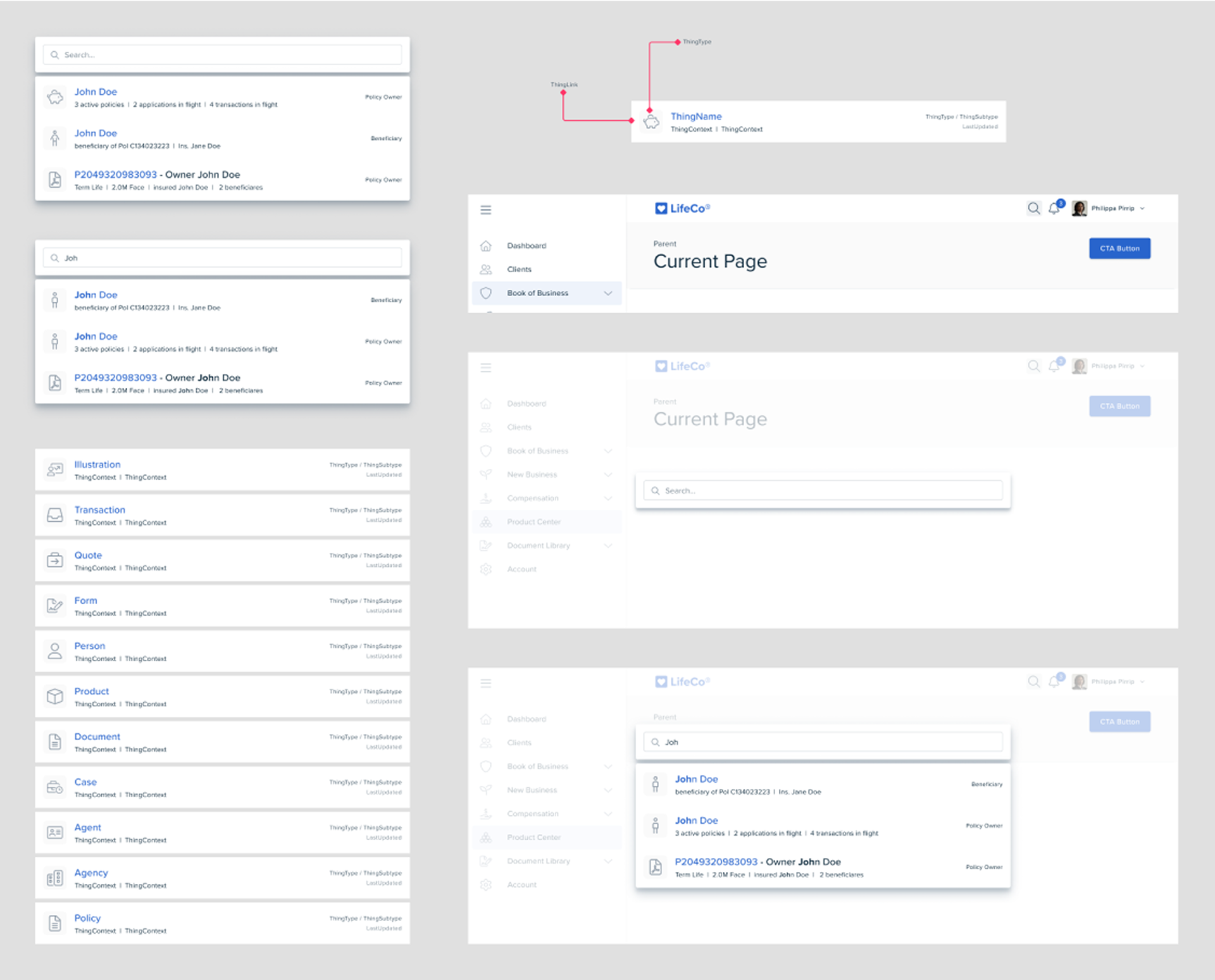
Centralize and extend agent-specific tools
Adding support for insurance agents as a primary citizen in the Sureify product ecosystem.
Overview
As a Staff product designer at Sureify, I led the design of LifetimeAgent, a comprehensive portal for life insurance agents that transformed our product ecosystem by creating a strategic channel between policyholder applications and our CoreConnect digital experience platform
While at Sureify, I witnessed impressive growth as the company expanded from 30 to 300 employees; I scaled the design team from a solo operation to a team of 10, and annual revenue jumped from around $100K to over $15M.
TL;DR
Led design for the first iteration of the Agent portal, driving the adoption of our experience engine in order to create a central data layer between the carrier and Sureify or other 3rd party vendors.
Final designs of the responsive agent portal.
Problem
As Sureify's product suite evolved, the need to support agents as a primary user type became clear. This provided a strategic opportunity to our new Digital experience engine, CoreConnect as an avenue for us to both serve this underrepresented user base and accelerate cross-platform integration.
Meanwhile, carriers struggled with outdated agent portals built in the early 2000s, creating friction for their sales force and disadvantaging them when recruiting independent agents, providing them with a modern tool for their exclusive agents would help cement our position as an industry leader.
In short, we needed to enable life insurance agents to connect with, and extract value from the Sureify Ecosystem that could interface seamlessly with our existing products.
This opportunity would enable us to address three key issues that existing in our current product offerings:
- Siloed Products: Without a centralized orchestrator, our existing products (LifetimeAcquire, LifetimeService, and LifetimeEngage) functioned as standalone solutions rather than an integrated ecosystem.
- Competitive Vulnerability: A lack of deep integration into the carrier’s systems meant that carriers could easily switch at only the cost of implementation, putting our market position at risk.
- Untapped Potential: Our new CoreConnect experience engine lacked a compelling use case for deep carrier integration.
Although our existing carrier panel enabled some of the required functionality, the configuration wasn’t suited to Agents as a primary user.
TL;DR
Integrate Sureify deeper into the carrier’s systems through building dedicated software for the carrier’s primary sales force (the exclusive agent) and enable data-connectivity to the rest of our policyholder-facing products.
Agent roles from research findings.
Defining the Scope
Research
To define a direction for the agent portal, I gathered insights by consulting with our anchor customer to determine parity requirements, analyzing competitor products, conducting agent interviews, and checking with internal subject matter experts.
This research clarified a few key points of how agents function, it helped me understand:
- Agent Personas: What the different types of agents were and how they operate.
- Workflow Analysis: Understanding agents' jobs-to-be-done and daily tasks.
- Value Perception: How agents evaluate which activities generate the most value.
- Carrier Preferences: Which carrier systems agents preferred and why.
- Boundary Definition: Clarifying what should be handled by our portal versus existing tools.
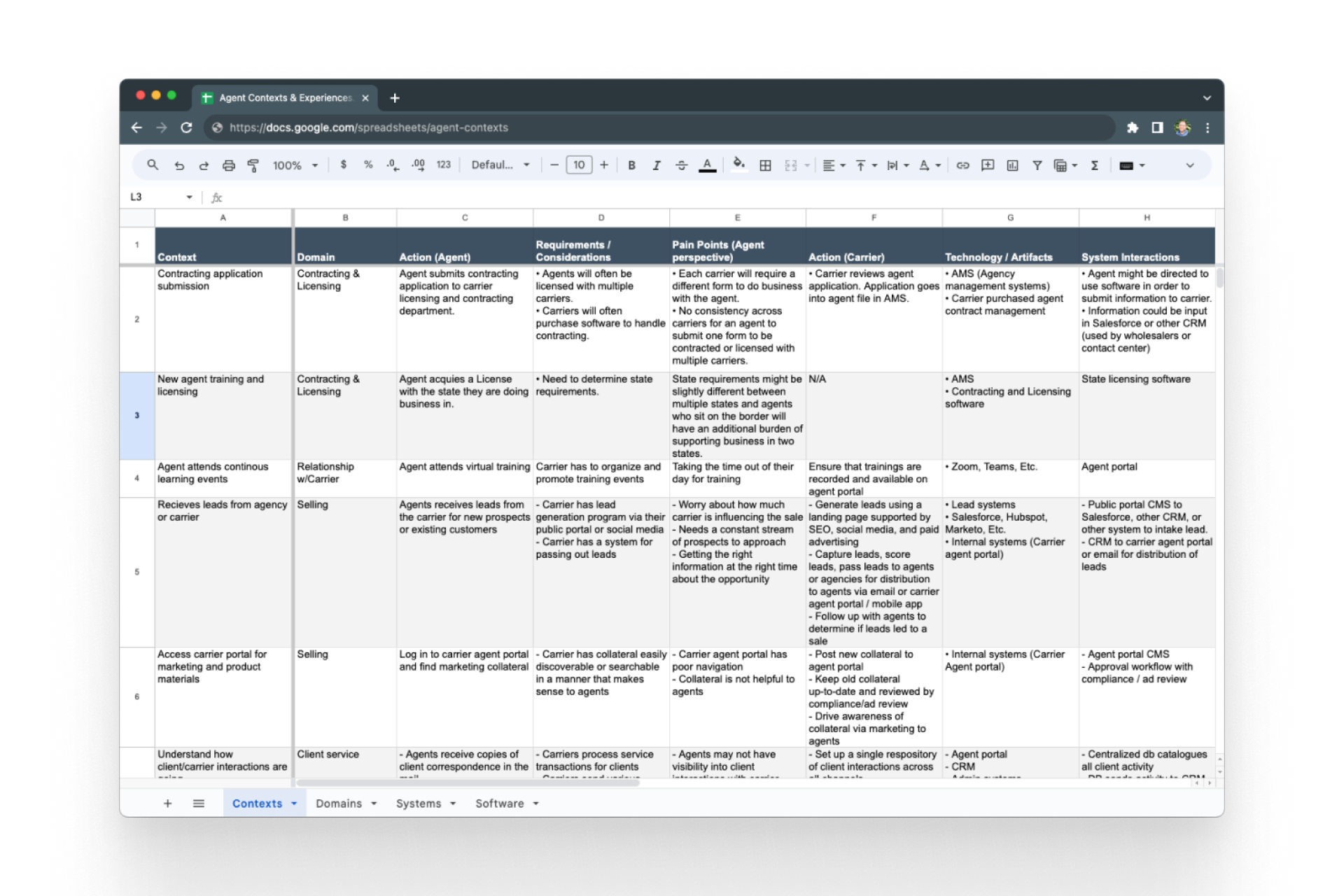
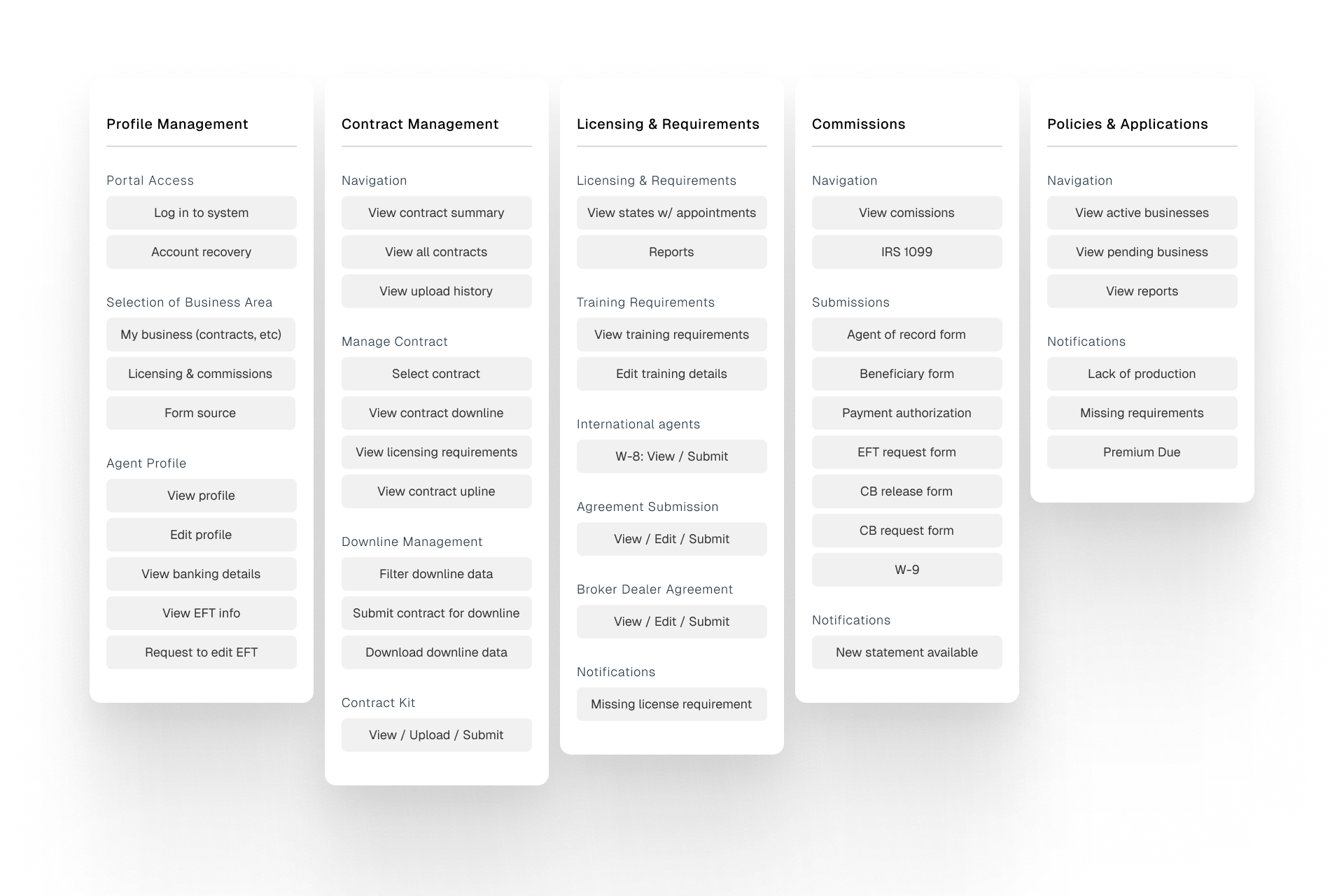
Context Mapping → Jobs-to-be-Done
Synthesis
I constructed a ‘context’ framework to align my research; mapping actions, pain points, technologies, and scenarios agents encounter daily. This framework became our team’s central research document and synthesized my research into a few key insights.
Agents don't generate revenue from servicing requests
Many agents operated with multiple agent IDs
TL;DR
- Agents delegated servicing tasks to assistants while focusing on new business development
- Many agents operated with multiple agent IDs, creating unnecessary login friction
- State-specific & Just-in-time licensing requirements complicated how agents presented products
Starting with a considered XA diagram helped me communicate the proposed scope of different milestones of the agent portal to the team.
UX Strategy
Prioritization
The MVP strategy focused on achieving functional parity with existing carrier portals to ensure a seamless transition for agents. As I worked closely with our technical architect and product manager, we reached agreement on several strategic decisions:
- Lean Functionality: Prioritize comprehensive read access to match existing functionality, while selectively implementing write access for high-value workflows where we could demonstrate immediate value.
- Entity Relationship Modeling: Design our data architecture to match how agents naturally conceptualize relationships between entities, rather than forcing them to adapt to system constraints.
- Carrier Alignment: Default to carrier requirements in cases of conflict, while strategically advocating for agent needs when backed by strong business cases.
Product Experience Insights
Research revealed unexpected gaps in how agents presented and sold specific insurance products:
- Presentation Mode: We designed a specialized view that automatically sanitized commission data and financial details when agents were sharing screens with potential clients, a feature agents hadn't explicitly requested but immediately valued.
- Licensing Management: We incorporated state-specific licensing requirements into the product filtering system, ensuring agents could only view and sell products they were properly licensed for.
Navigating Carrier Complexity
Our anchor client was a conglomerate carrier that had acquired three separate insurance companies, each with different processes and data models. This complexity became an unexpected advantage; when agent requests aligned with the need to standardize across these different brands, we gained significant leverage to shape the product in ways that better served agent needs.
For instance, how I translated 'agent impersonation' was initially met with resistance, but became widely accepted when we demonstrated how it would simplify the administration of agents who worked across multiple brands within the conglomerate.
Early iterations of the agent portal wireframes, the early layout sensibilities were retained in the final design but the functional complexity shifted dramatically.
TL;DR
- Build for feature parity first
- Map entity relationships (policies, Agent IDs, etc) to how actual users think about them
- Identified opportunities (Dashboard customization needs, Context-sensitive action buttons)
- Improve the product sales experience (licensing management, presentation mode)
Final Design
Agent Dashboard designs for desktop and mobile.
Agent impersonation dropdown designs.
Human-Centered Identity Management
One of our most transformative innovations addressed how agent identities were managed in the system. Traditionally, carrier portals treated each agent ID as a separate login, forcing agents with multiple IDs (common when inheriting books of business from retired agents) to constantly log in and out of different accounts. Our solution reframed the relationship model through:
- Human-Centered Design: Associating multiple agent IDs with a single person, allowing seamless switching between books of business without logging out.
- Regulatory Compliance: Since product licensing is regulated at the person level (not agent ID level), this model simplified compliance management across multiple books of business.
- Transparent Activity Tracking: The system clearly tracked which person took which action under which agent ID, maintaining accountability while simplifying the user experience.
- Hierarchical Access: Upline agents could temporarily view and take actions on behalf of their downline agents without credential sharing, maintaining security while enabling supervision.
Global search with contextual icons and data.
Surfacing Enhanced Information Architecture
The global spotlight-style search feature directly addressed the challenge of navigating fragmented books of business:
- Context-Aware Results: Search results were categorized by object type (policy, client, application) and visually distinguished with icons for rapid scanning.
- Cross-ID Discovery: Agents could search across all their associated agent IDs from a single interface, with clear indicators showing which ID each result belonged to.
- Relevance Prioritization: Results were weighted to prioritize likely needs based on agent context and activity patterns.
The "pizza tracker" provided an indicator of application progress.
Transparent Process Tracking
Status tracking bars provided clear visibility into each case's progress:
- Responsibility Indicators: The system highlighted which actions needed to be completed by which party (agent, carrier, client) to move the process forward.
- Blockers Identification: Visual cues revealed where processes were stalled and who needed to take action.
CoreConnect diagram designed by Rachel Long.
Integration Architecture
The entire agent portal was built atop our CoreConnect platform, creating a powerful demonstration of its capabilities:
- Data Orchestration: CoreConnect served as the central nervous system, pulling information from carrier systems and pushing agent-initiated changes back.
- Standardized Integration: By routing all interactions through CoreConnect, we established a consistent pattern for carrier system integration that could be replicated across clients.
Various segments of the desktop application.
TL;DR
The final UI design balanced functionality with visual clarity:
- Clean, information-dense layouts for power users
- Consistent visual hierarchy across screens
- Responsive design optimized for desktop but adaptable to mobile
Outcome
Impact
The agent portal project fundamentally shifted Sureify's strategic position:
- Ecosystem Integration: By establishing CoreConnect as the central data layer, we created network effects across Sureify's product offerings, driving value for carriers embedded in our ecosystem.
- Client Success: The successful launch for our anchor client helped them unify their product experience across previously disconnected brands.
- Market Differentiation: The portal solidified Sureify's evolution from a point-solution provider to an essential platform partner for carriers navigating digital transformation.
- Design System Contributions: Evolved Sureify's design system through the creation of reusable components for agent-specific workflows and established usability patterns for how we handled complex data relationships in our designs.
Reflections & Learnings
This complex, multi-stakeholder project provided several valuable insights on my design approach:
- Cross-Functional Collaboration: Working with technical architects, offshore development teams, and industry experts taught me the importance of translating complex requirements into a shared vision. Creating a visual language that bridged technical and business perspectives proved essential for alignment.
- Domain Expertise: The project deepened my understanding of the insurance industry's unique structures, relationship models, and regulatory environment - knowledge that has proven transferable to other complex industries with similar multi-tiered relationship structures.
- Technical Integration: Recognizing how design decisions cascade into complex system architecture. This understanding has shaped how I approach platform design thinking in subsequent projects.
- Strategic Product Thinking: The project demonstrated how a single product can serve as a strategic lever for broader business objectives. The agent portal wasn't just a tool for agents, but a cornerstone for Sureify's entire ecosystem strategy.
In future similar projects, I would focus on establishing clear success metrics earlier to better measure impact and ROI, exploring technical constraints to identify additional UX improvement opportunities and develop a more proactive timeline that builds in buffer for product improvements discovered during the development process.
Various views of the agent portal on desktop.

Interested in working together? Contact me!
© Anders Houston 2024




